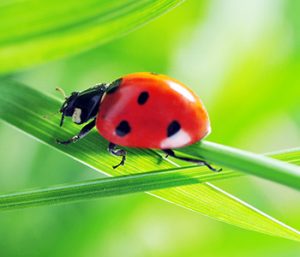Ladybugs
Biology
Ladybugs are common throughout North America. Adult ladybugs are round, semi-circle shaped insects with short legs and antennae. They have small heads and are colored red with black dots. The coloring of dots and their amount can change from the different species of ladybug. In some species the coloring is reversed making them black with red dots.
Ladybugs lay their eggs on aphid infested leaves to assure their larvae has immediate access to food. They also lay clusters of eggs that include infertile eggs mixed in with the fertile for the same purpose for a ample food supply. Ladybug larvae do not look like the adult beetle. The larvae are normally blue with black or orange stripes. They have 3 sets of legs and have a much longer body than in the adult stage. The life cycle from egg to adult takes one to two months. The average life span of adults ladybugs is normally 2 to 3 years.
Feeding Preferences
Most species of ladybug adults and larvae are appreciated by farmers because they eat different types of plant-damaging insects, mostly aphids.
Transmitted Diseases
Ladybugs do not transmit human diseases.
Habits
In North America ladybugs begin to appear indoors in the fall. They are looking to shelter from the cooler temperatures and find a protected area away from the winter elements.
Ladybugs have three main defenses against predators. Their brightly colored bodies warn potential predators that it is poisonous, even though these beetles are not. Ladybugs also secrete a bad tasting fluid when attacked which makes them an unwanted prey. Last, these beetles can play dead! When faced with a threatening situation, ladybugs pretend they are dead until the danger is gone.
They normally live in shrubs, trees, fields, gardens, and other plants that attract aphids. These beetles relocate once they eat all the aphids on one plant.
Ladybugs hibernate in the winter, therefore, finding a protected and warm environment in the late fall is imperative. This is when you will commonly see them around or inside your home or structure.
Structural Pest Ladybug Program
David will perform a thorough inspection on both the interior and exterior of your home, finding all the infested areas and identifying which pests you are dealing with. Once identified, David will employ a pest control program that is designed to target the specific pests in your home.


